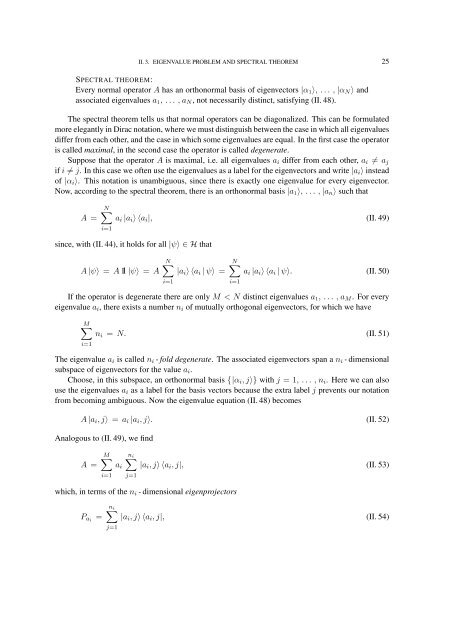FOUNDATIONS OF QUANTUM MECHANICS
FOUNDATIONS OF QUANTUM MECHANICS
FOUNDATIONS OF QUANTUM MECHANICS
You also want an ePaper? Increase the reach of your titles
YUMPU automatically turns print PDFs into web optimized ePapers that Google loves.
II. 3. EIGENVALUE PROBLEM AND SPECTRAL THEOREM 25<br />
SPECTRAL THEOREM:<br />
Every normal operator A has an orthonormal basis of eigenvectors |α 1 ⟩, . . . , |α N ⟩ and<br />
associated eigenvalues a 1 , . . . , a N , not necessarily distinct, satisfying (II. 48).<br />
The spectral theorem tells us that normal operators can be diagonalized. This can be formulated<br />
more elegantly in Dirac notation, where we must distinguish between the case in which all eigenvalues<br />
differ from each other, and the case in which some eigenvalues are equal. In the first case the operator<br />
is called maximal, in the second case the operator is called degenerate.<br />
Suppose that the operator A is maximal, i.e. all eigenvalues a i differ from each other, a i ≠ a j<br />
if i ≠ j. In this case we often use the eigenvalues as a label for the eigenvectors and write |a i ⟩ instead<br />
of |α i ⟩. This notation is unambiguous, since there is exactly one eigenvalue for every eigenvector.<br />
Now, according to the spectral theorem, there is an orthonormal basis |a 1 ⟩, . . . , |a n ⟩ such that<br />
A =<br />
N∑<br />
a i |a i ⟩ ⟨a i |, (II. 49)<br />
i=1<br />
since, with (II. 44), it holds for all |ψ⟩ ∈ H that<br />
A |ψ⟩ = A 11 |ψ⟩ = A<br />
N∑<br />
|a i ⟩ ⟨a i | ψ⟩ =<br />
i=1<br />
N∑<br />
a i |a i ⟩ ⟨a i | ψ⟩. (II. 50)<br />
i=1<br />
If the operator is degenerate there are only M < N distinct eigenvalues a 1 , . . . , a M . For every<br />
eigenvalue a i , there exists a number n i of mutually orthogonal eigenvectors, for which we have<br />
M∑<br />
n i = N. (II. 51)<br />
i=1<br />
The eigenvalue a i is called n i - fold degenerate. The associated eigenvectors span a n i - dimensional<br />
subspace of eigenvectors for the value a i .<br />
Choose, in this subspace, an orthonormal basis {|α i , j⟩} with j = 1, . . . , n i . Here we can also<br />
use the eigenvalues a i as a label for the basis vectors because the extra label j prevents our notation<br />
from becoming ambiguous. Now the eigenvalue equation (II. 48) becomes<br />
A |a i , j⟩ = a i |a i , j⟩. (II. 52)<br />
Analogous to (II. 49), we find<br />
A =<br />
M∑<br />
i=1<br />
a i<br />
∑n i<br />
j=1<br />
|a i , j⟩ ⟨a i , j|, (II. 53)<br />
which, in terms of the n i - dimensional eigenprojectors<br />
P ai =<br />
∑n i<br />
j=1<br />
|a i , j⟩ ⟨a i , j|, (II. 54)
















